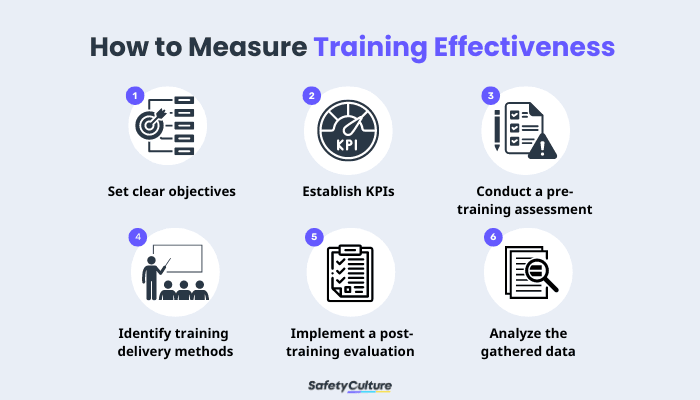What is Training Effectiveness?
Training effectiveness measures how well a training program accomplishes its intended objectives and delivers desired results. Simply put, it can help organizations determine whether or not their employees can absorb knowledge from their training and turn it into practical skills.
Importance and Benefits
Measuring training effectiveness offers several benefits that can contribute to the success of your teams and organization as a whole. Some of the benefits include:
1. Talent Development and Retention
Training programs play a crucial role in talent development and retention. Measuring training effectiveness allows you to identify high-potential employees who benefit from the training and show a significant capacity for growth within the organization.
It also helps you identify any gaps in training that may hinder the development and retention of skilled employees, allowing you to take corrective actions to address these gaps.
2. Return on Investment (ROI)
Training programs often require a significant investment of time, money, and resources. Measuring training effectiveness can give you insights into whether this investment results in the desired outcomes. You can then make proper decisions about resource allocation and optimize training budgets by determining the ROI of training initiatives.
3. Employee Engagement and Satisfaction
Effective training fosters a positive learning environment and contributes to employee engagement and satisfaction. When your employees perceive that their training is relevant, impactful, and aligned with their career goals, they are more likely to be motivated and committed to their work. Measuring training effectiveness helps you identify areas where training can be improved to enhance employee engagement and satisfaction.
4. Compliance and Risk Mitigation
In certain industries, compliance with regulations and best practices is critical. Measuring training effectiveness ensures that your employees receive the necessary training to comply with regulations and mitigate risks associated with non-compliance. It also helps you track and document employees’ training completion, ensuring that legal and regulatory requirements are met.
5. Employee Performance Improvement
Another benefit of understanding training effectiveness is that it allows you to identify areas where employees need to improve. By analyzing the impact of training on performance, you can tailor future training programs to address specific skill gaps and enhance overall productivity.
By analyzing feedback, assessing learning outcomes, and monitoring the impact of training on performance, you can make data-driven decisions to refine training content, methods, and delivery approaches. The continuous improvement process also helps your organization stay relevant and adapt to changing business needs.
Factors for Effective Training
To make training effective, it’s important to combine different elements strategically to get the best learning results. Four main factors play a big role in the success of any training program:
1. Clear Goals
An effective training program has specific and measurable objectives that match the overall goals of the organization. You must be able to communicate learning objectives to your team members so that the training stays on track.
2. Interesting Content and Presentation
Training materials should be well-organized, current, and presented in a way that grabs participants’ attention. You can use different methods like interactive activities, real-life examples, and practical exercises to keep your team members engaged and help them remember what they learn.
3. Relevance to Participants
Training works best when team members see it as relevant for their roles and career growth. You need to take into account your employees’ prior knowledge and skills when designing training programs. You can also encourage active participation through discussions and group activities to deepen their understanding.
4. Support and Evaluation After Training
Effective training doesn’t end when the session is over. You should be able to offer support and evaluation tools to reinforce learning and its application. This could include resources, mentoring, coaching, or opportunities for on-the-job practice. You can also assess the training’s effectiveness through quizzes, surveys, or feedback to continually improve future training efforts.
While these factors are crucial, other factors can also affect training effectiveness, including organizational culture, managerial support, trainee motivation, and the learning environment. This is why it’s important to take a comprehensive approach to impactful training programs.
How to Measure Training Effectiveness
Figuring out if your training is making a difference is super important. So, this step-by-step guide is here to break down the key parts of measuring training effectiveness, giving you easy tips and methods to get started.

6 Steps to Measure Training Effectiveness | SafetyCulture
Step 1: Set Clear Objectives
Begin by establishing clear and specific objectives for the training program. These objectives should be aligned with your organization’s overall goals and define the desired outcomes of the training.
Step 2: Establish Key Performance Indicators (KPIs)
Determine the KPIs that will be used to measure the effectiveness of the training. KPIs can vary based on the training program and organizational needs but may include training metrics such as employee performance, productivity, knowledge acquisition, customer satisfaction, or employee engagement.
Step 3: Conduct a Pre-training Assessment
Carry out a pre-training assessment to identify the baseline of your employees’ knowledge, skills, or performance levels before the training program. This assessment can take the form of surveys, tests, or evaluations.
Step 4: Identify the Appropriate Training Delivery Method/s
Implement the training program according to the established objectives and intended methodology. This may involve various methods such as classroom training, online courses, simulations, on-the-job training, or a combination of approaches.
Step 5: Implement a Post-training Evaluation
Once the training is completed, you can evaluate its effectiveness through different methods like post-training assessments, surveys, feedback forms, observations, or interviews. This can indicate your team members’ perceptions, knowledge gain, skill improvement, and behavior change.
Step 6: Analyze the Gathered Data
Collect and analyze the data obtained from the post-training evaluation. Look for patterns, trends, and insights to determine the effectiveness of the training program. Compare the post-training results with the baseline data to assess whether the training helped your team improve their performance.
By following these steps, you can systematically measure the effectiveness of your training programs, make informed decisions, and continuously enhance your employee development initiatives.
Best Practices for Effective Training
Whether it’s for onboarding new team members, upskilling existing staff, or enhancing their professional competencies, here are some tips to help you make your training programs more effective:
- Understand your audience: Customize the training to meet the needs of your participants. Consider their prior knowledge, learning styles, and job roles to make the training relevant to them.
- Use interactive content: Keep your team engaged using a variety of training strategies. You can include group discussions, case studies, simulations, and hands-on activities to enhance learning and retention.
- Utilize technology: Take advantage of technology for training purposes. Virtual learning platforms, e-learning modules, webinars, and online resources offer flexibility and accessibility for different learning styles.
- Provide real-world application: Connect theory with practical examples and scenarios. Your employees are more likely to remember and apply what they learn when they can relate it to their daily tasks and challenges.
- Encourage collaboration and peer learning: Foster a collaborative environment where your team members can share insights and experiences. Peer-to-peer interactions promote knowledge exchange and create a supportive learning community.
- Give feedback and assess progress: Regularly provide feedback and assessments to track your participants’ progress. Constructive feedback helps them understand their strengths and areas for improvement, reinforcing the learning process.
- Be flexible and adapt: Recognize that people learn at different paces and have different preferences. Offer flexibility in training schedules and formats to accommodate diverse needs. Also, be open to adjusting the training content based on feedback and organizational changes.
- Measure and re-evaluate: Implement methods to measure the effectiveness of the training program. Assess key performance indicators, such as improved job performance, increased productivity, or enhanced employee satisfaction. You can then use this data to improve future training initiatives.
With these best practices in mind, organizations can create a training environment that not only imparts knowledge but also fosters a culture of continuous learning and development.
Challenges
Measuring training effectiveness is a complex task covering various factors to determine whether the training is working or not. This poses several challenges, including:
- Time and Resource Constraints: Conducting a comprehensive training evaluation requires significant time and resources. Many organizations face limitations in terms of budget, personnel, and technology, which can hinder their ability to conduct thorough assessments of training effectiveness.
- Attribution of Results: Isolating the impact of training from other factors that influence performance is a complex task. Multiple variables, such as job environment, prior experience, and individual motivation, can affect employee performance. It can be challenging to attribute improvements solely to the training program.
- Transfer of Learning: Another challenge is ensuring that the knowledge and skills acquired during training are effectively transferred to the workplace. Employees may struggle to apply what they have learned in real-world scenarios, leading to a gap between training outcomes and on-the-job performance.
- Feedback Reliability: Gathering reliable feedback from trainees, managers, and other stakeholders is crucial for evaluating training effectiveness. However, subjective feedback may be influenced by various factors, such as personal biases, social desirability, or limited self-awareness. It can be challenging to obtain unbiased and accurate feedback.
- Long-term Impact: Measuring training effectiveness immediately after the completion of a program may not capture its long-term impact. It is essential to assess whether the acquired knowledge and skills are retained and utilized over an extended period. However, tracking long-term changes can be logistically difficult and time-consuming.
- Technology Integration: In the era of digital learning, incorporating technology for effective training measurement is vital. However, organizations may face challenges in selecting and implementing suitable technologies, ensuring compatibility with existing systems, and dealing with data security concerns.
To overcome these challenges, organizations can employ a combination of methods, including pre-and post-training assessments, surveys, interviews, on-the-job observations, and performance evaluations.
Additionally, leveraging data analytics systems and learning technology solutions such as Training can provide valuable insights into training effectiveness.
FAQs about Training Effectiveness
Key Performance Indicators (KPIs) measure how well employees are performing and whether they’re engaging with training initiatives. Some of the most common training and development KPIs include:
- Course completion rate
- Average time to completion
- Learning retention rate
- Training attendance rate
- Post-training assessment outcomes
To give your employees time to absorb their training and effectively apply the knowledge, it’s advisable to wait two or three months after they’ve completed their training program. Setting training schedules and tracking periods in advance also gives you a timeframe to work with, allowing you to properly set expectations with stakeholders.
Training efficiency refers to how well resources such as time, money, and materials are utilized in the training process. On the other hand, training effectiveness measures the extent to which learning objectives are achieved and how well the newly acquired skills or knowledge are applied in real-world situations. To put it in simpler terms, training effectiveness is focused more on assessing the impact and outcomes of a training program, while training efficiency evaluates its cost-effectiveness and time-saving aspects.
Based on how the training is given, the way it’s presented, the subject, and other factors, you’ll have different types of survey questions you’ll want to ask employees and learners after the training.
To give you some ideas, here are five common training effectiveness example survey questions:
- Did the training program meet your expectations?
- How would rate the quality of the training program?
- Was the training program interactive and engaging?
- How relevant was the training to your role?
- Did you have enough time and resources to complete the training program?



